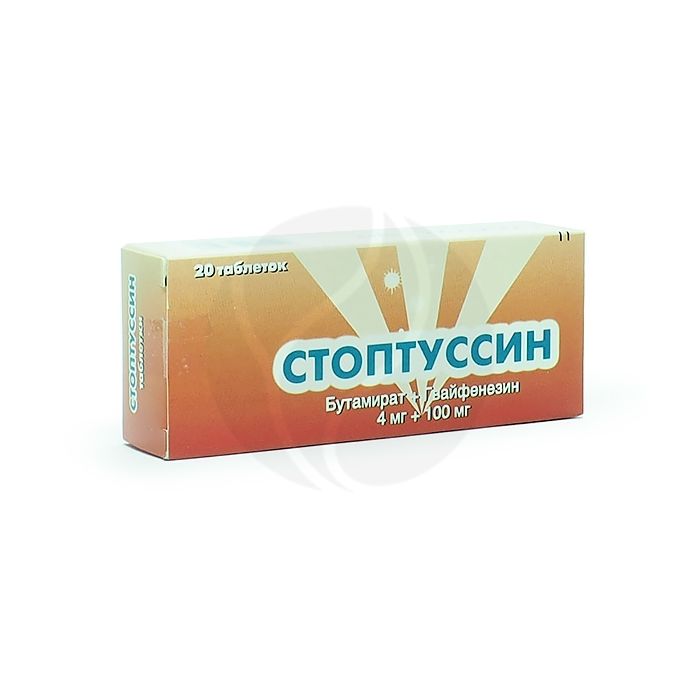Stopussin tablets, No. 20
Expiration Date: 05/2027
Russian Pharmacy name:
Стоптуссин таблетки, №20
Dry irritating cough (including with infectious and inflammatory diseases of the upper and lower respiratory tract).
Inside, after a meal, without chewing, drinking a liquid (water, tea, fruit juice, etc.).
The dose depends on the patient's body weight.
Adults and children over 12 years of age with weight:
less than 50 kg: 1/2 tablet 4 times a day;
from 50 to 70 kg: 1 tablet 3 times a day;
from 70 to 90 kg: 1 1/2 tablets 3 times a day;
more than 90 kg: 1 1/2 tablets 4 times a day.
The interval between doses should be 4-6 hours.
1 tablet contains:
active substances: butamirate citrate 4.0 mg; guaifenesin 100.0 mg;
excipients: colloidal silicon dioxide 1.0 mg, mannitol 60.0 mg, microcrystalline cellulose 60.0 mg, glyceryl tribegenate 1.0 mg, magnesium stearate 4.0 mg.
Myasthenia gravis;
children under 12 years of age;
I trimester of pregnancy;
lactation period (breastfeeding);
hypersensitivity to the components of the drug.
pharmachologic effect
Combined drug that has a mucolytic (expectorant) and antitussive effect. Butamirate dihydrogen citrate has a peripheral local anesthetic effect on the sensitive nerve endings of the bronchial mucosa, which provides an antitussive effect. Guaifenesin increases the secretion of the bronchial glands and reduces the viscosity of mucus. An increase in secretion is due both to a direct effect on the bronchial glands - stimulation of secretion from the bronchial glands and the removal of acidic glycoproteins from acinar cells, and by reflex, when the afferent parasympathetic fibers of the gastric mucosa are irritated and the respiratory center is inhibited. Increased tone n. vagus stimulates the production of bronchial secretions. The mucus produced by the bronchial glands enhances the activity of the ciliated epithelium,as a result, the evacuation of mucus from the bronchi and its coughing up is facilitated.
Pharmacokinetics
When taken orally, dihydrogen citrate is rapidly and completely absorbed from the gastrointestinal tract. Plasma protein binding is 94%. Undergoes metabolism with the formation of 2 metabolites, which also have an antitussive effect. T1 / 2 - 6 hours. Metabolites are excreted mainly (90%) by the kidneys and only a small part through the intestines. Guaifenesin When taken orally, guaifenesin is rapidly absorbed from the gastrointestinal tract. Plasma protein binding is negligible. Guaifenesin is rapidly metabolized, with the formation of inactive metabolites, which are excreted by the kidneys. T1 / 2 - 1 h.
Side effect
From the nervous system: often - headache.
On the part of the organ of hearing and balance: often - dizziness.
From the digestive system: often - nausea, anorexia, abdominal pain, vomiting, diarrhea; very rarely - a bitter taste in the mouth, heartburn, a feeling of heaviness in the epigastrium.
From the respiratory system: very rarely - shortness of breath.
From the side of the cardiovascular system: rarely - chest pain; very rarely - tachycardia, palpitations.
On the part of the skin and subcutaneous fat: very rarely - itching, exanthema, urticaria.
Others: very rarely - hot flashes, pain around the eyes.
Application during pregnancy and lactation
Stopussin should not be used in the first trimester of pregnancy. If it is necessary to use it in the II and III trimester of pregnancy, you should make sure that the intended benefit to the mother outweighs the potential risk to the fetus. There is no reliable data on the penetration of butamirate and guaifenesin into breast milk. It is necessary to stop breastfeeding during the period of use of the drug Stopussin.
Application in children
Contraindication: children under 12 years of age (tablets).
special instructions
During the period of drug treatment, it is not recommended to consume alcoholic beverages.
Influence on the ability to drive vehicles and use mechanisms
The drug in high doses can have an adverse effect on activities requiring increased attention, coordination of movements and quick decision-making (for example, driving, servicing cars and working at heights).
Overdose
Symptoms: Signs of toxic effects of guaifenesin are drowsiness, nausea and vomiting. Treatment: gastric lavage, intake of activated charcoal, symptomatic therapy, there is no specific antidote for guaifenesin.
Drug interactions
The effect of guaifenesin is enhanced by lithium and magnesium preparations. Guaifenesin enhances the analgesic effect of paracetamol and acetylsalicylic acid; enhances the effect of sedatives, hypnotics and general anesthetics on the central nervous system; the action of muscle relaxants, ethanol.

